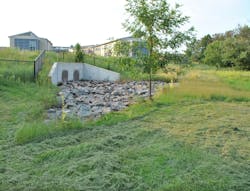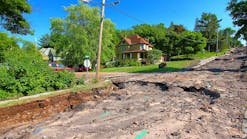The goal of green infrastructure is to design with nature; to let nature be part, if not most, of the solution to managing stormwater. This design concept is used to address stormwater rate, volume and quality with additional benefits of heat mitigation and air quality. Although the greatest green infrastructure mitigations are usually applicable to smaller storms (occurring 95+ % of the time), its integration is demonstrated in several case studies to provide resilience from 100- even up to 1,000-year storms.
But, before delving into examples using green infrastructure (which are sited in Pennsylvania), let us briefly discuss the history of design challenges and the evolution of guidance and permitting on this topic.
According to the guidance set in the 2000s, the two-year volumetric increase in runoff after development must be infiltrated. However, one could follow this infiltration protocol to remove water volume and still have a discharge point stability problem. Additionally, although infiltration will work for many projects, it will not be entirely feasible in every case. This can be due to, for example, clay soils, shallow rock geology, prior development, severe karst or even contamination.
The stability problem primarily stemmed from situations where a naturally occurring sheet flow was not effectively replicated after development. Incorporation of level spreaders at the outfall was not always successful in maintaining sheet flow, particularly in high discharge rate applications. Even after rate and volume reductions, erosive downstream conditions were not uncommon. In 2011, I presented a whitepaper through the PA Stormwater Technical Workgroup. My proposed supplement used a slow-release approach, only after demonstration that infiltration is maximized and other options are exhausted, to allow the balance of required volume management credit. This supplemental design guidance was updated after PADEP review of stormwater codes, and academic research, formally issued in 2018 as the Managed Release Concept (MRC).
MRC refers to the extreme delayed discharge of captured runoff over many days via a specialized outlet structure to mimic the natural hydrologic process of soil through-flow. Slowing the discharge down facilitates incorporation with green infrastructure, improving settling, filtering, water quality and evapotranspiration. In other words, it replicates how nature handles runoff horizontally when vertical infiltration is limited, and on a timescale and pace that nature is already adapted to.
In the pending update to the PA BMP Manual, MRC is to be formally integrated, rather than serving as the supplemental guidance of today. However, this design approach can be presently applied to almost any stormwater best management practice.
The following are specific constructed cases where the MRC approach is coupled with green infrastructure to effectively create “green armor” that withstood the worst forces of Mother Nature.
The Manavon Elementary School site was a former golf course with an adjacent high-quality stream. Construction occurred from 2015 to 2017. A 150-foot buffer setback from the stream was required, any disturbance warranted additional permitting. The existing site also had a large 45-acre area of sheet flow along a 900-foot boundary. Fortunately, the Manavon site allowed standard infiltration. Underground beds and naturalized surface basins removed volume.
At the end of the treatment train, a constructed wetland basin addressed peak high-rate reductions. However, to achieve final water quality credits, the constructed wetland basin’s small storm discharge needed secondary treatment. MRC ideals were used for a slow discharge of small storm events (98% of all) to a level spreader through the buffer for final filtering credit. This level spreader flow path was offset from the primary system overflow point to address erosion concern for large discharges over a continually saturated area. The primary discharge from two 42-inch pipes would happen infrequently, once every two years on average.
The solution was to lay down a high-density polyethylene (HDPE) web material on top of existing grass to stabilize the offset level spreader flow path, as well as the occasional high-rate discharge path. The web installation caused no disturbance, did not affect the stream/floodplain, and therefore required no additional controls or permitting.
During last September’s Hurricane Ida — which caused more than $100 million in damage to public infrastructure in Southeastern Pennsylvania alone — 9 inches of rain fell over six hours on the Manavon site. This exceeded the emergency overflow design by 150%. Even with a reduced rate, the primary outfall’s dual 42-inch pipes discharged over 100 cubic-feet per second each. With all BMPs functioning in harmony with GI, other than some slightly matted grass at the outfall, it was hard to tell anything happened. The matrix of grass and web at the concentrated outfall was resilient to a 1,000-year storm through the 150-foot buffer.
Another successful green stormwater infrastructure example is the Malvern Redevelopment project, constructed from 2017 to 2019. The existing office and light industrial site were redeveloped into a multi-family residential facility. The existing site had a 17-acre half-impervious drainage area to an existing basin. Although constructed in the 1980s, analysis showed the basin over-controlled rates well in smaller storms. The site had severe karst (sinkhole) limitations and infiltration was not possible. In the existing basin’s place, we proposed an enlarged green infrastructure constructed wetland retrofit with slow release that maintained the existing over-control. To replicate the existing discharge pattern, we installed level spreaders to split the water discharge flows and replaced existing eroded channels with permanent turf-reinforcement-mat lined bioswales with naturalized plantings and amended soils.
The bioswales in this case would be saturated by the slow discharge and would also need to be resilient to high flow conditions. Hurricane Ida at this site was ‘only’ a 750-year storm. Nonetheless, the BMPs designed to mitigate a 100-year storm withstood Ida without issue. There were no adverse effects to the basin and no damage in the downstream bioswales whatsoever. These are just a few real-world examples of how pre-existing design challenges can be solved and converted into successful green infrastructure case studies. Historic storms will continue, but effective design of green armor can keep us prepared.
Zachary Ranstead
Zachary Ranstead, PE, LEED AP, CFM, is supervising engineer for T&M Associates. Ranstead can be reached at [email protected].






